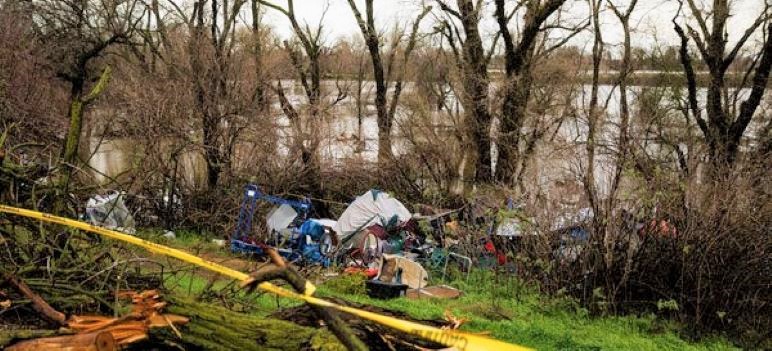A New York Times project explores what homelessness is really like.
Yvonne Soy had to move out of her apartment in Contra Costa County because she couldn’t pay her rent. She began living in her car, with her two cats, and tried to get work as a secretary or a legal administrator.
But the showers at the local homeless shelter didn’t open until 8:30 a.m., too late for her to get to work on time. So she began collecting recyclables to afford cat food and litter. Soy, who is now 66, said she was homeless for seven years in total.
“It was pretty much, one, very boring and, two, very boring,” she told The New York Times. “That’s the reason why homeless people go to the library: not just to sleep but to read or use the computer. If you don’t have that, what are you going to do? You’re just going to sit and do nothing. And who can do that for hours at a time?”
Soy is one of 30 people The Times profiled about their experience with homelessness, part of an effort to illuminate the challenges and occasional mundanity of unhoused people’s lives. “Even as homelessness becomes more common, most of it remains hidden by design,” wrote Matthew Thompson, an editor who oversaw the project.
On any given night in the United States, more than 580,000 people may be experiencing homelessness, according to a 2022 report from the U.S. Department of Housing and Urban Development released in December. Approximately 30% of them live in California, despite the state’s accounting for 12% of the nation’s population.
The Times project focused on the wide range of people’s experiences, highlighting stories of those who were born into homelessness and those who fell into it in their 60s. There are people who ended up on the streets because of a crack addiction or severe mental illness, and others who simply lost their jobs.
Still, many of the stories shared a common thread: Before losing their homes, people had become distanced from friends and family who may have been able to provide financial support or offer them a temporary place to stay, said Aidan Gardiner, who conducted the interviews with another reporter, Susan Shain. Gardiner mentioned James Reed, a 55-year-old man in Santa Clara who became homeless after his parents kicked him out of their house because of debilitating mental health issues.
“You see versions of this rejection, or just outright destruction of a social network,” Gardiner told me. “Without that safety net, they just fall right through.”
The stories revealed many paths into homelessness, including the many wildfires that have swept across the West Coast in recent years, Gardiner said. Fifteen of the 20 most destructive fires in California history took place in the past decade.
Ana, who asked to withhold her last name, moved from Oregon to the Santa Cruz Mountains to live with and work for a 93-year-old woman there. In August 2020, a wildfire burned down the woman’s house.
As Ana was heading back home two weeks later, she learned that a wildfire in Talent, Ore., had destroyed the storage unit where she had kept all her belongings. “I had writings, ceramics, wood furniture, important documents, our nest egg, all the photographs from my whole life,” Ana, 70, told The Times.
Since the fires, she has slept in her car and on friends’ couches, and has little stability. “It’s maddening,” she said. “I don’t sleep much. I’m awake all night, crying and praying and trying to figure out what to do.”
Read all 30 stories in the Times’ online interactive.
Soumya Karlamangla is a reporter for California Today, published by The New York Times. Copyright, The New York Times.


“You’re just going to sit and do nothing. And who can do that for hours at a time?”
Who can do that? Seemingly about 50,000 people in Santa Clara County can do that, that’s who. Do we provide health services to treat their mental illnesses or drug addiction? Nope, we give them cell phones and tents to use along our creeks and rivers then toss the majority of homeless funding down the toilet on a token number of virtue-signaling tiny homes and pay homelessness consultants. Until we start providing the medical care these people need zero dollars should be spent on anything else related to homelessness such as consultants or tiny homes.
Didn’t bother to mention that the drug & alcohol addictions are largely responsible for the mental illness. Nor that the addictions are largely responsible for the family and friends distancing themselves from them. Nor that Democrat administrations have been allowing the rampant flow of illegal drugs to flood across our borders causing addiction nation wide.
But whatever, we know your paid for the propaganda pieces.
Bad enough we have the junior college level San Jose Sob-Light (SJS) pushing almost constant activism and advocacy for the unaccountable and unproductive vagrants & transients that destroy the environment, community and taxpayers enjoyment of their hard earned homesteads.
The NYT’s can take their sob “stories” and add a dose of reality in which adults make adult decisions on career choices, where they can afford to live and taking personal responsibility for their lifestyle choices and situations.
Just an Observation,
just like in 2007 they blamed the poor and the minorities for the economic collapse of the great recession.
The same song playing out here, but 2023 Residential and Commercial Mortgage Backed Securities, Real Estate Values, and MANY Residential and Commercial Landlords are going to go bankrupt.
Looks like your trying to put the blame on the WORNG people still. Trying to say it is the homeless that is the problems.
This is just scapegoating because the REAL AGONY is on they way for you.